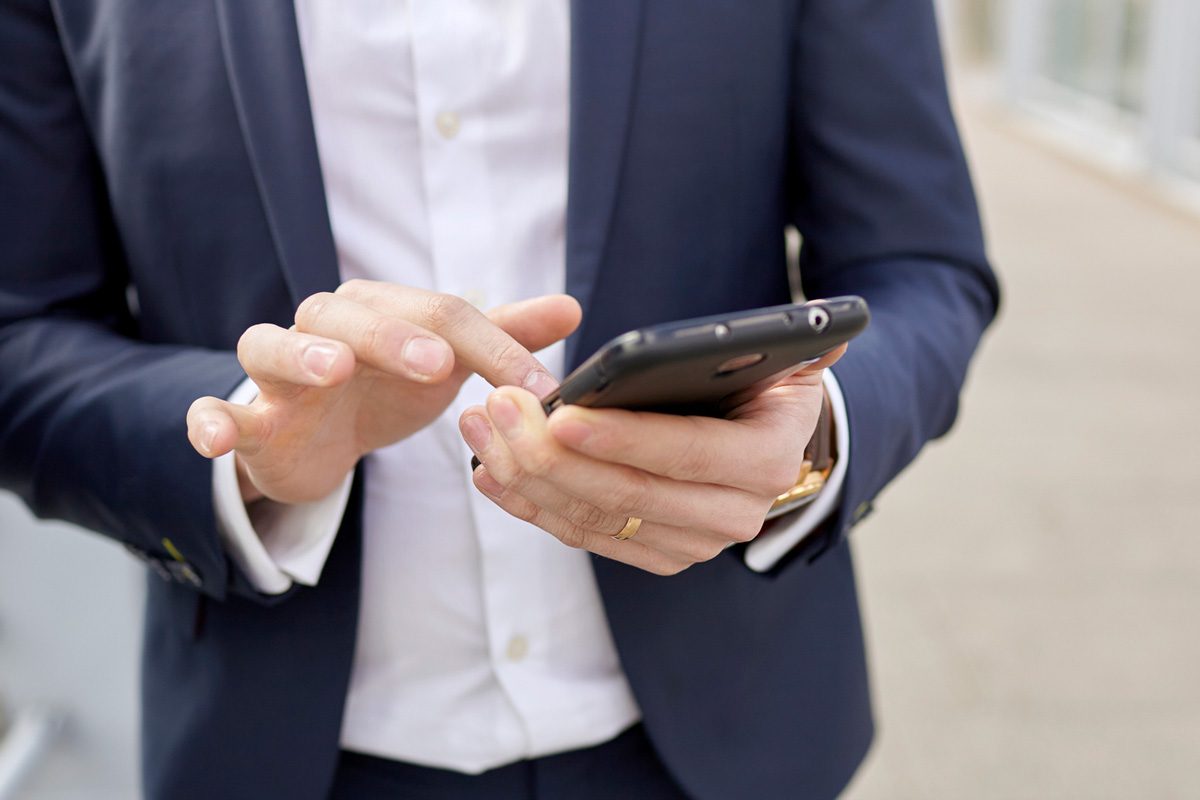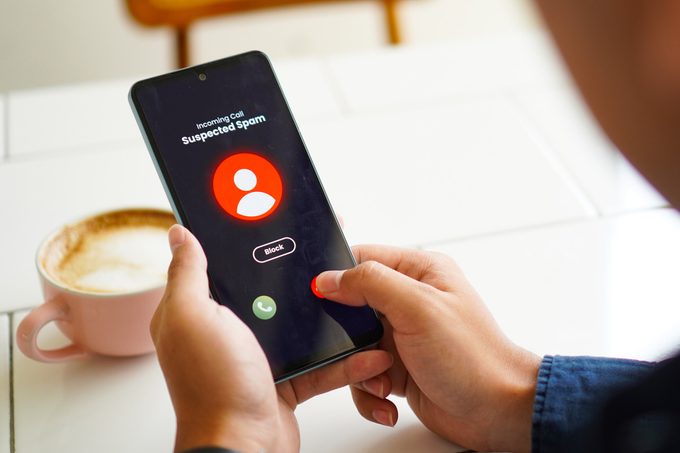Received a call from an unfamiliar number that rang only once? It could be a scam phone call. Here's how to avoid and report it.

Got a Call From One of These Area Codes? It Could Be a Scam

If your phone rings just once from a three-digit area code, you may assume the call is coming from somewhere in the United States and be tempted to call the number back. But satisfying your curiosity could cost you—it might be an international number, which may make you the victim of a scam phone call. According to a 2024 Trucaller Insights report, more than 56 million Americans were impacted by scam calls in the previous year, collectively losing over $25.4 billion.
So how can you protect yourself from one-ring phone scams? Ahead, cybersecurity expert Joseph Steinberg explains what the scam is, how to stop spam calls and where to report these telephone fraud.
Get Reader’s Digest’s Read Up newsletter for more tech, travel, cleaning, humor and fun facts all week long.
What are area code phone scams?
In this scam phone call, also known as the one-ring phone scam, the scammer uses what appears to be a U.S. phone number beginning with the familiar three-digit format of an area code, which gives the victim a false sense of security that the call is domestic. However, phone scammers are tricky and sometimes use international numbers from countries with a three-digit country code.
“Criminals have been known to use caller IDs with the area code 473, which appears to be domestic but is actually the area code for the island of Grenada,” Steinberg says. Scam calls from area code 473 are so common, it’s sometimes referred to as the “473 scam.”
How these scams work
The unknown caller hangs up after one ring, banking on you returning the call out of curiosity. The return call itself could cost you $5 per minute or more for international rates or premium connection fees, of which the scammer gets a portion. And once the scammer has you on the line, they may use a variety of strategies to get you to stay on the line, racking up charges and attempting to access to your personal info, accounts and funds. These tactics could include:
The “say yes” or “four-word” scam
In reports of the four-word phone scam, the scammer poses a yes or no question, such as “Can you hear me?” or “Are you the homeowner?” to get you to say “yes.” The reason for this scam has become something of an urban legend: As the story goes, they can then use the recording of your voice to authorize major purchases or log in to your accounts.
There are more recent concerns that scammers may use the recording to clone your voice with the help of artificial intelligence (AI) technology, possibly to use your impersonated voice in another scam AI phone call to a loved one.
But the Better Business Bureau says it has never received any reports that mention monetary loss from these four-word calls. Possibly, the scammer is just trying to find out if the number they called is in service. But no matter the reason, it’s best not to respond at all. When you don’t know the number, let it go to voicemail: If it’s a real call, the caller will leave a message.
The distress call
The scammer plays a recording of someone in distress, sometimes a loved one or friend, to elicit a fear-based response. When our amygdala—the part of our brain responsible for processing emotions—is activated, emotions may override logical thinking. The victims of these types of scams may be quicker to share personal information or offer to send funds to help if they believe someone they care about is in danger.
In some cases, the call seems to come from a random person, with the caller sharing a desperate story in the hopes you’re a good Samaritan who will be willing to help them by sending them money. “Remember that it’s unlikely that someone you do not know—who is in distress at a location with which you are not familiar—would dial a random number in another country and ask you to help them,” Steinberg says. “They would call the police.”
The secret admirer
The scammer gets you excited by playing a song and saying it’s from someone you love—but you have to listen to the end to hear who it’s from. This keeps you on the line to rack up those per-minute charges.
Scammers may also try to get your information by saying you’ve won a prize or a trip. You haven’t, so don’t give them any personal details.
The imposter
Scammers also try to get a fear-based response out of you by pretending to be someone from:
- Your bank
- The IRS
- The Social Security Administration
- Your credit card company
- Law enforcement
- Another authority
The caller may say your account has been suspended or has a suspicious charge or that you need to pay a fine, taxes or some other fee urgently or else you’ll be in big trouble. But according to the Federal Trade Commission (FTC), real law enforcement and federal agencies won’t call and threaten you, and no government agency is going to call you out of the blue and ask for sensitive information like your Social Security number. Don’t give them any account or password info, hang up and call the real number to confirm if it was a scam or not.
An imposter pretending to be an authority may try to get you to pay money right away in a way that’s difficult to get back, such as by wire transfer, gift card, cryptocurrency or payment app. If they insist you pay this way, they’re scamming you.
How can you avoid the one-ring scam phone call?

Here are some expert tips to help you avoid the one-ring scam and stop spam calls from reaching you:
- Don’t pick up. Never answer or return a call from a number you don’t recognize. If you actually know the person, they can always leave a voicemail or contact you via other methods if needed.
- Look up the number. If you’re an entrepreneur, freelancer or otherwise in a situation where taking and returning calls from unknown numbers is necessary (I get it!), research the number before ringing them back. That way, you can see if there’s an area code scam alert for the number.
- Block unwanted calls. You can download mobile phone security apps and ask your telecom provider to enable call-blocking features.
- Block outgoing international calls. If you don’t regularly need to make international calls, you can also ask your telecom provider to block outgoing international calls. This can prevent you from mistakenly calling one of the foreign area code scam numbers.
- Sign up for the National Do Not Call Registry. This will stop legitimate telemarketer calls, but not illegal phone scams—so if the call gets through, you’ll know they’re scammers.
- Choose a secret word. I recommend setting a secret word with close friends and family to use only in case of emergency. If you receive a call and the person says they’re your loved one and in trouble, then they should be able to tell you the secret word. If they don’t know the word, they’re likely a scammer employing an AI-cloned voice.
Which area codes are commonly used in phone scams?
Certain international area codes with a telltale +1 international code can warn potential targets that the call isn’t safe, Steinberg says. Here are some to look out for—if you don’t typically make or receive calls from these locations—as they have been reported in connection with phone scams:
- 232: Sierra Leone
- 242: Bahamas
- 246: Barbados
- 268: Antigua
- 284: British Virgin Islands
- 345: Cayman Islands
- 441: Bermuda
- 473: Grenada, Carriacou and Petite Martinique
- 649: Turks and Caicos
- 664: Montserrat
- 721: St. Maarten
- 758: St. Lucia
- 767: Dominica
- 784: St. Vincent and Grenadines
- 809, 829 and 849: The Dominican Republic
- 868: Trinidad and Tobago
- 869: St. Kitts and Nevis
- 876: Jamaica
Beware of spoofing
In addition to the above, keep in mind that scammers also use something called spoofing to make it appear that the phone number they’re calling from is a U.S. number familiar to you, such as a number in your area code. In some cases, it could even be from your own number!
A good rule of thumb that I try to stick to: If it’s an unfamiliar phone number, let it go to voicemail. This can also help you avoid falling for other common phone scams, such as those pesky car extended warranty calls.
What should you do if you called back a scam number?
If your curiosity got the better of you and you rang back a scam number, here’s what you should do next.
- Secure your accounts. Change your passwords and monitor your credit report, bank and credit card accounts.
- Report any charges. Contact your bank (or any other platform or financial institution the scammers accessed) as well as your phone company. Ask them if they can investigate the fraudulent charges and issue a refund.
- Report the number. Report suspicious numbers and scam calls to your telecom service provider, the Better Business Bureau, the FTC and the Federal Communications Commission (FCC). If you didn’t lose money, you can report a suspected scam call at the FTC’s National Do Not Call Registry. Contributing these reports can create awareness and help with preventing scam phone calls.
About the expert
|
Why trust us
Reader’s Digest has published hundreds of articles on personal technology, arming readers with the knowledge to protect themselves against cybersecurity threats and internet scams as well as revealing the best tips, tricks and shortcuts for computers, cellphones, apps, texting, social media and more. For this piece on the scam phone calls, Brooke Nelson Alexander tapped her experience as a tech and cybersecurity writer to ensure that all information is accurate and offers the best possible advice to readers. We rely on credentialed experts with personal experience and know-how as well as primary sources including tech companies, professional organizations and academic institutions. We verify all facts and data and revisit them over time to ensure they remain accurate and up to date. Read more about our team, our contributors and our editorial policies.
Sources:
- Joseph Steinberg, expert in cybersecurity, privacy and artificial intelligence and author of Cybersecurity for Dummies
- Truecaller: “U.S. 2024 Spam & Scam Report”
- Federal Communications Commission: “‘One-ring’ phone scam”
- Federal Communications Commission: “Consumer Inquiries and Complaints Center: Unwanted calls/texts”
- Better Business Bureau: “Scam Tracker”
- AT&T: “One-ring call scams”
- Federal Trade Commission: “Report Fraud”
- Federal Trade Commission: “Phone Scams”
- Federal Trade Commission: “Scammers Use Fake Emergencies To Steal Your Money”























